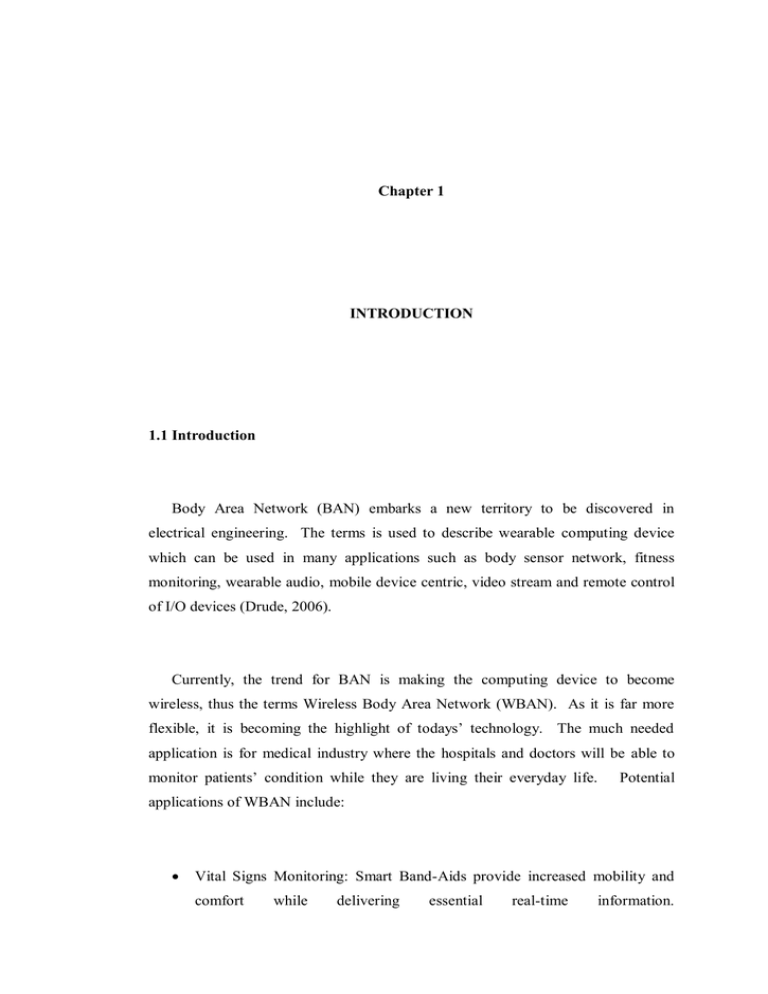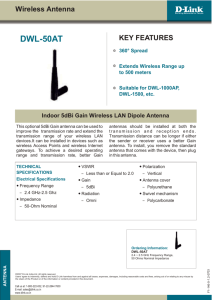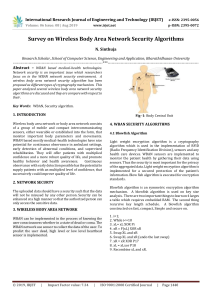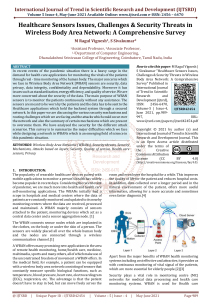Chapter 1 INTRODUCTION 1.1 Introduction
advertisement

Chapter 1 INTRODUCTION 1.1 Introduction Body Area Network (BAN) embarks a new territory to be discovered in electrical engineering. The terms is used to describe wearable computing device which can be used in many applications such as body sensor network, fitness monitoring, wearable audio, mobile device centric, video stream and remote control of I/O devices (Drude, 2006). Currently, the trend for BAN is making the computing device to become wireless, thus the terms Wireless Body Area Network (WBAN). As it is far more flexible, it is becoming the highlight of todays’ technology. The much needed application is for medical industry where the hospitals and doctors will be able to monitor patients’ condition while they are living their everyday life. Potential applications of WBAN include: Vital Signs Monitoring: Smart Band-Aids provide increased mobility and comfort while delivering essential real-time information. 2 Proactive Cardiovascular Monitoring: Identify potential heart attacks before they happen using sensors implanted in (or worn on) the body to monitor sophisticated vital signs over wireless networks. Organ Implantation Monitoring: Monitor organ transplant recipients after discharge for signs of transplant rejection using implanted sensors. Seizure Monitoring: Wearable sensors allow clinical neurologists to monitor epileptic patients remotely in real-time and provide each patient biofeedback to help manage their condition. The WBAN systems works in three hierarchical stages (Jovanov et. al., 2005). The first one is the sensors in WBAN itself. They will transmit the data to the personal server and by connecting the personal server to the internet, it will be connected to medical server where the doctors can monitor the patients’ conditions. Though it has been implemented, but there are no standard rules for the system. In 2009, the Federal Communications Commissions (FCC) has proposed technical rules for the operation of Medical Body Area Network (MBAN) systems (Dolan, 2009). It is a response to a request made by GE Healthcare. The FCC also has proposed a few frequency allocations which are 2.3-2.305 GHz, 2.36-2.395 GHz, 2.4-2.483Ghz, 3.65-3.7 GHz and 5.15-5.250 GHz. The project mainly is to design a multiple band antenna that transmits the data obtained by the sensor in WBAN to the personal server. It concentrates to the medical application in BAN. This chapter will discuss on the problem statement, objective and the purposed scope of work. 3 1.2 Problem Statement This project is purposed when several problems were detected in a few antennas that have been designed before for WBAN applications. They were; Lack of antenna that works at two different frequencies for WBAN applications. High frequency antenna affected by physical distance and dielectric properties of human tissues. The antennas do not work in FCC purposed ranges of frequencies. 1.3 Objective For this project, the objective is to design a prototype of multiple band antenna that works at least in two (2) range of proposed Federal Communications Commission (FCC) frequency allocation for wireless body area network (WBAN). 4 1.4 Scope of Work The scope of work defines the boundaries of the project. That is necessary since it conducted in limited time. For this project, it will need to complete within one semester, which is just four (4) months. Thus, the scope of work is important so that work will be done within that duration. The scope of work for this project is divided into two parts, which are hardware and software. After so much consideration and reasons that will be discussed in next chapter, the proposed antenna will be done in microstrip patch design. And as it is a multiband antenna, it will minimally function in two FCC proposed frequencies ranges for BAN applications. Before fabricating the antenna, the design of the antenna will be simulated using Computer Simulation Technology (CST) software. The result obtained will be compared to the actual result from the fabricated antenna itself. The antenna will be analyse using network analyser. 1.5 Conclusion As the problem statement, objective and scope of work were discussed in this chapter, they will provide a sense of direction and guidance for the proposed project. The methodology used must be aligned with those criteria. In the next chapter, study of previous projects will be presented as they helped in shaping the method used in this project.






